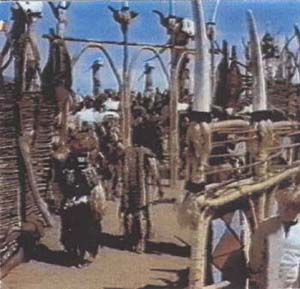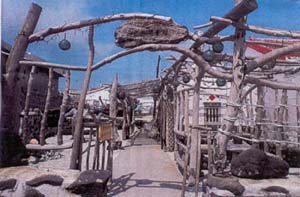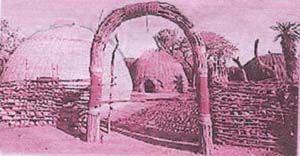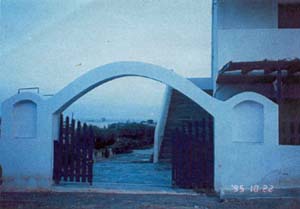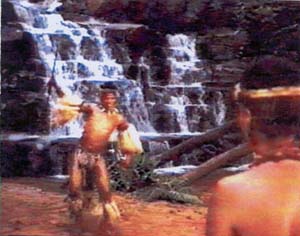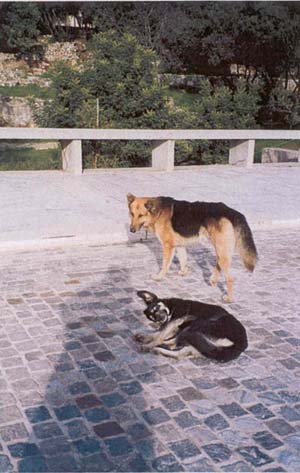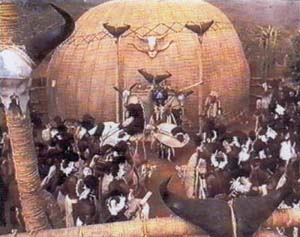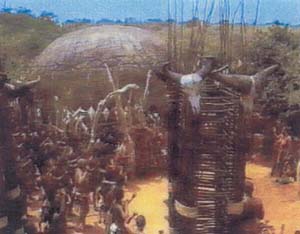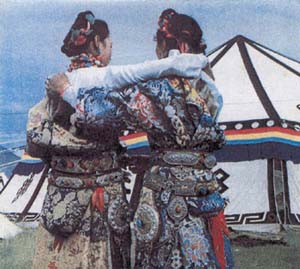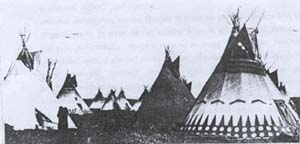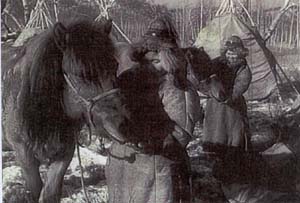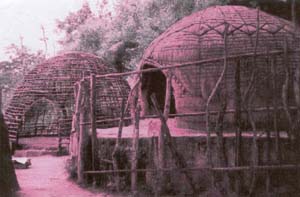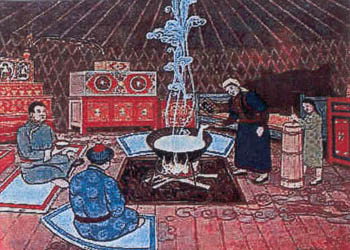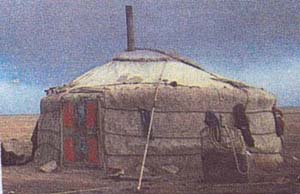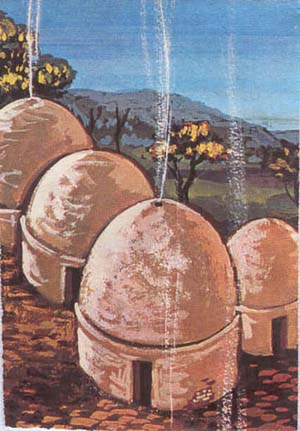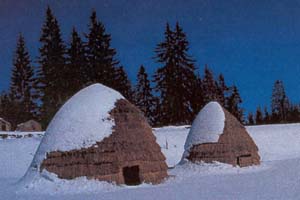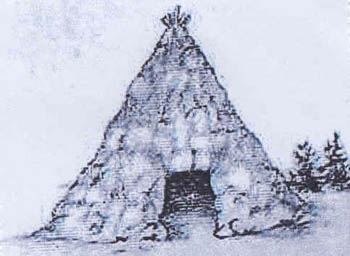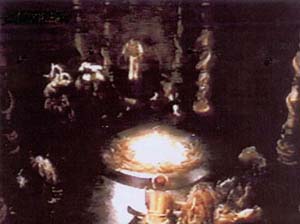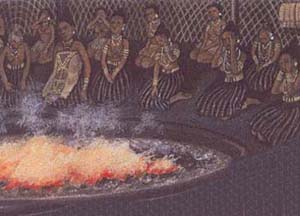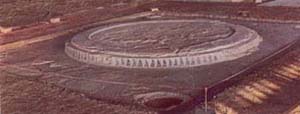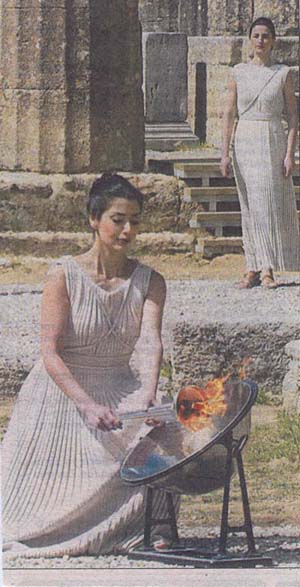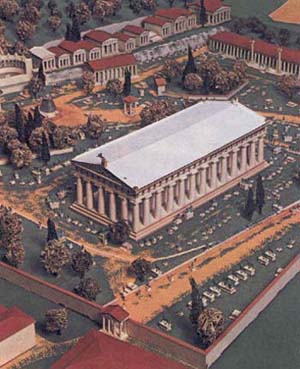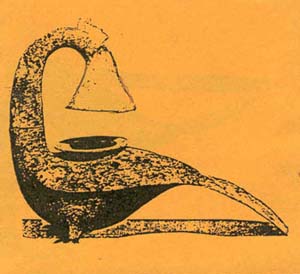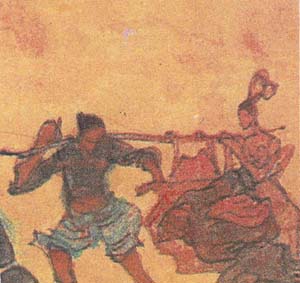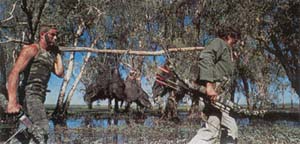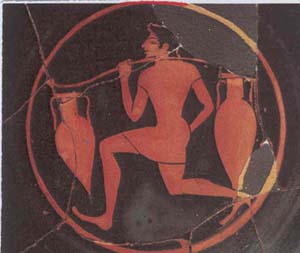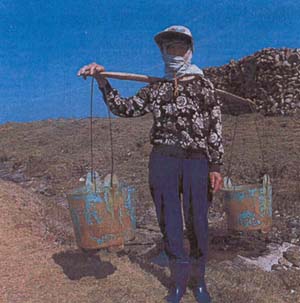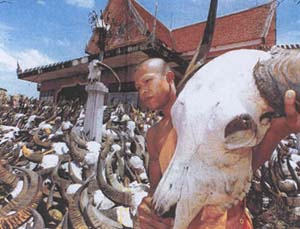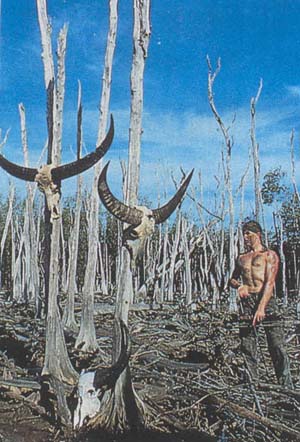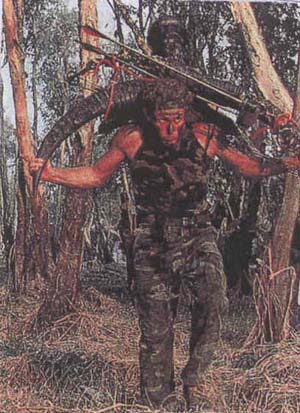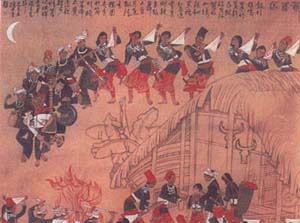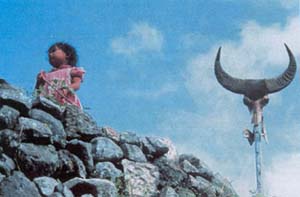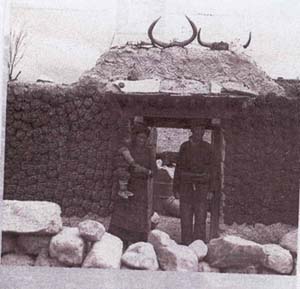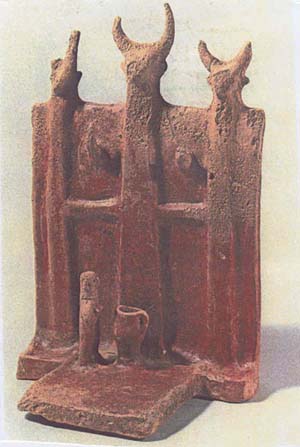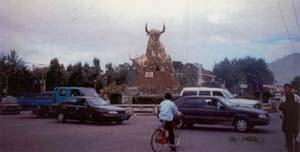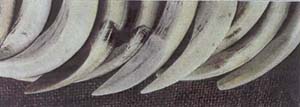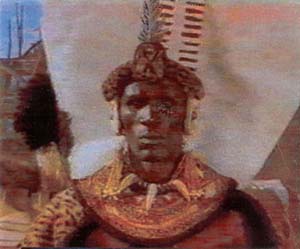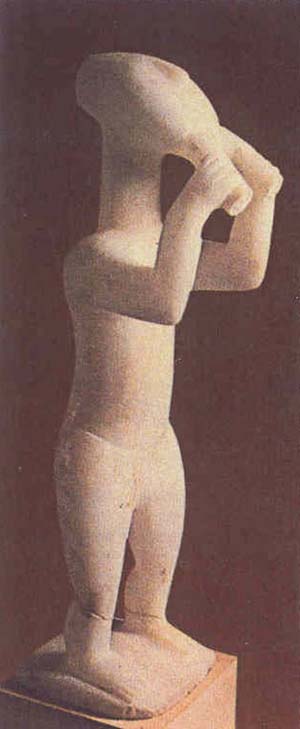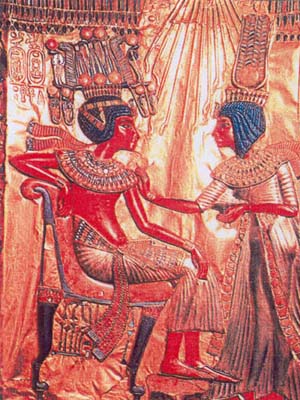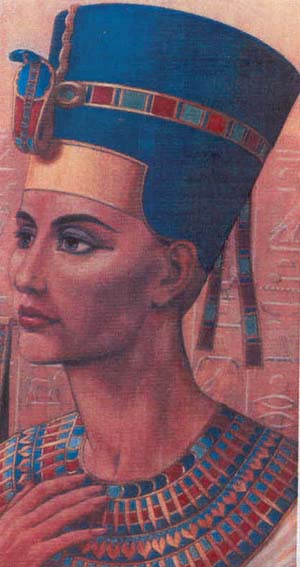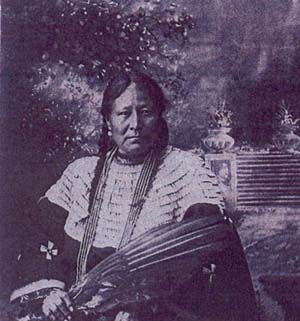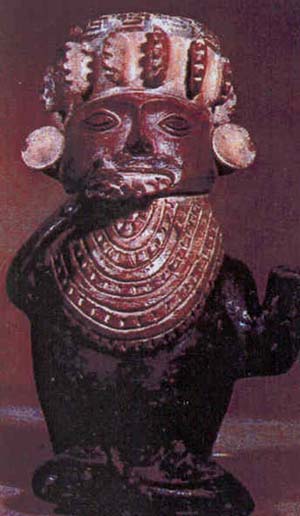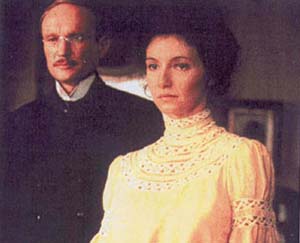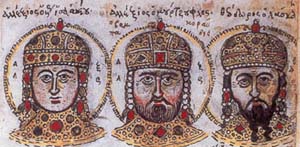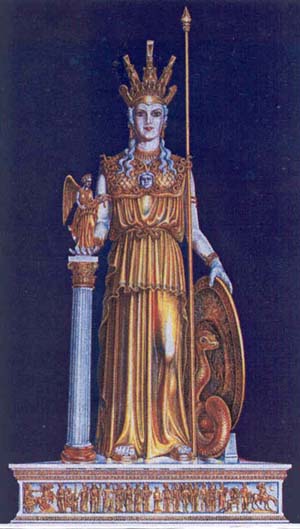THE ZULU RELATIONSHIP TO THE GREEK AND CHINESE CULTURES IN 400 PICTURES
Archways and rhombuses for protection
A Zulu village in the early 19th century. It is surrounded by a fence made of drift wood. Crooked wood above the entrances form archways (snake symbolism) and similar doorways have, today, our churches and houses. To the right rhombuses for protection (snake skin).Photo from the movie Shaka Zulu |
Taiwan. "At the Tidal zone Museum the locals (Peng he aboriginals) built themselves the drift wood fence". On the wooden column to the right "fish scale design (viper skin for protection). Photo SINORAMA,
Shakaland-Eshowe. Zulu village for Tourists. Photo Internet. |
|
Kytheira island. Summer house in the village "Diakoftis". |
Shakas mother and father flirting like the animals.
Prince Senzangakona, Shaka's father, was impressed by the beauty of Nandi, Shaka's mother. To seduce her he started jumping around her, yelling and screaming like an animal. |
|
Southern slope of the Acropolis (D.Areopaghitou). February 2003. A male dog was going around and around a female making circles and barking flirting her. |
Beehive - like Zulu straw dwellings
On the huts symbolic patterns (rhombuses, zig-zag, X design) to keep Evil out and buffalo heads attached on the huts and on wooden poles. A Zulu village was always circular and built on sloping ground. The main hut of the headman stood at the highest point
|
|
The same symbolic patterns on Zulu huts and on Tibetan and American Indian tents.
Circles (snake) and meander (snake) on a Tibetan tent. |
Tents (tipi) of Northamerican Indians, similar to Mongolian tents, with the same circles.
From the movie OROQEN by Yang Guanghai about Inner Mongolia. |
The Mongolian "yurt", round dwellings of Cyprus and of the Greek nomads. |
|
|
Zulu Village |
In the center of the "yurt" or "ger' like inside the Greek Palaces and the Zulu hut was the hearth. |
| Zulu village, today, for Tourists. A big hut was "30 feet in diameter and about 20 feet high at the dome" Up to 1500 huts enclosed by the outer palisade, a mile in diameter. An inner palisade at the center of the village surrounded the place for the cattle. | |
|
The Mongolian yurt |
The neolithic stone settlement of Choirokoitia on Cyprus. |
|
Straw huts of Greek nomads (Sarakatsanides)"near Drama, Macedonia |
Alternative shelter to the "ger" was the "ursa'' |
The hearth of the Mycenaean palaces and of the Zulu hut.
In the center of the hut the hearth "Slightly oval in slightly sunken ground was burning day and night the year around . Inside the Mongolian yurt a fire was always burning because of the cold climate. |
Photo from the book SHAKA of Diane Stanley.
The "slightly oval" hearth in the center of the throne room of the Mycenaean palace of Pylos (Messenia). About 1,300 BC. |
|
Lighting the torch in Olympia for the 2004 Olympics in Athens |
With the abolition of Kingship the fire burning inside the Palace was transferred to the Temple.
Bronze Chinese oil-lamp in the shape of a phoenix-bird of the W.Han dynasty. |
| The fire of the Olympic games was burning day and night inside the Temple of Zeus in an altar and from there was brought to the stadium. On the Acropolis the eternal fire was burning inside the Erechtheion Temple which was in the area of the Palace in an oil-lamp made in the shape of a phoenix-bird (and not of a phoenix-palm tree) like Chinese "high fidelity" lamps (see T.Mitsopoulou "The other Santorini", p.313). | |
Transporting game and goods on bamboo poles.
Photo from a Chinese children's book. The hero Yi (the Chinese Hercules) killed a wild boar and carried on a shoulder pole to offer it to the Supreme being. |
Zulu hunters coming back to the village with their game hang on a wooden pole (the first one, the prince, Shaka's future father, has a leopard around his shoulders. They have bands around their heads. |
The Buffalo Head
Hunters at Northern Australia carry buffalo heads on a wooden pole.They wear bands around their head like the Zulus. Carrying wine jars on a shoulder pole. Floor medallion of a kylix. 500 BC. Athens Agora Museum. Buffalo horns on poles and worn as crowns.... |
Taiwan. Hsiyu. Penghe women carry water on shoulder poles to irrigate the fields.
Bangkok, Tailand. The Temple "Buffalo head" with 3,000 buffalo skulls with horns. |
|
Northern Australia. Wild buffalo skulls on poles |
An Australian hunter with a buffalo horn. |
|
"Celebration for moving into a new house". On the facade are attached two buffalo heads to keep Evil out of the house. |
Luson island (the largest of the Philippine islands). The Ifugaos, its ancient inhabitants, decorate their houses with buffalo craniums mounted on poles. |
|
A peasant house in Jiangze town, Tibet. |
Clay sanctuary (about 2,000 BC) from Cyprus. Nicosia Museum |
|
Central square in Lhasa, Tibet. |
Necklaces made of buffalo teeth to ward off Evil. |
The round collar of Shaka, of the Pharaoh and of the Byzantine Emperor. The necklace of buffalo teeth.
Shaka with buffalo teeth necklace and a round collar symbolizing the snake similar to that of the Pharaohs and of the Byzantine Emperors. On his head a ring covered with leopard (or otter) skin with feather like those worn, even today, by the aboriginals of Taiwan. |
A Pawnee American Indian, known as "Man and Chief." . He has two feathers on his hat, a necklace of buffalo teeth and symbolic patterns on his jacket and trousers. Photo taken in Washington in 1858. The design of his trousers (snake symbolism) will decorate the shields of the Zulus and the Greeks. |
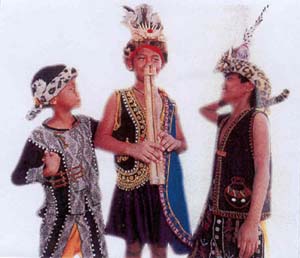 Taiwanese aborigines with head-rings covered with leopard or otter skin with feathers and double nose-flute. Photo SINORAMA, January 2001. Shaka "round his bare head used to wear a circlet of stuffed otter skin bearing plumes...". |
Double mouth-flute. Cycladic (2,500 BC). Marble. From Keros, Athens Arch.Museum. |
|
The back of Tutankhamen's wooden throne. 18th dynasty. From the Valley of the Kings. He is wearing ''the snake" around the neck and has one on the head. Cairo Museum |
Queen Nefertiti. 18th dynasty. On her hat all around and hanging behind knotted the snake with its head on the forehead. Symbolic snake-collar around her neck. |
|
The wife of an Indian Chief ("Yellow hair"). A 1900 photo by John AJvin Anderson. |
The same "imperial necklace" in South America. |
|
Same collar and "rings" on the sleeve around the arm. From the 1989 movie "Ragtime" (America around 1900)
Byzantine Emperors with the same "collar" of Shaka. Modena Biblioteca Estense. 15th c.illustrated manuscript. |
Athena with rings-snakes around the arrn and rectangular collar-Aegis with the Medusa head. |
